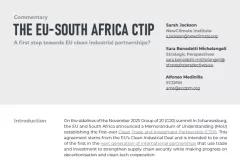Major fashion companies replacing coal with biomass risk promoting a false solution. Although often labelled as a renewable source, biomass is far from emissions-free and cannot be considered a sustainable alternative to coal given its climate, environmental and social impacts. To truly align with a 1.5°C pathway, fashion brands should prioritise electrification of manufacturing processes, powered by renewable energy.
As London Fashion Week kicks off this Thursday – and with Milan and Paris still to come – the runways will dazzle with new collections. Yet behind the glamour, the industry’s climate commitments should also be under scrutiny, especially its reliance on false solutions like biomass to replace coal.
Amid growing pressure to cut emissions, several fashion companies, through the UN Fashion Industry Charter, have committed to phasing out coal in their supply chains. While this marks a major step forward for corporate climate strategies, the real impact depends on what replaces coal. Too often, many companies are switching to biomass, framing it as a transition fuel.
But replacing coal with another unsustainable fuel such as biomass will not deliver the climate benefits companies promise.
“Biomass is not an emissions-free energy source and often comes at high costs for local ecosystems and communities,” explains NewClimate expert Silke Mooldijk. “Companies shifting from coal to bioenergy risk locking in a polluting energy source, instead of transitioning to actual low-carbon alternatives.”
The problem of swapping coal with biomass
The fashion industry is a major contributor to global emissions. The United Nations Environment Programme estimates that it is responsible for between 2-8% of the world’s greenhouse gas emissions. Around 85% of the sector’s total footprint comes from energy use in garment manufacturing.
In Asia, where much of the world’s fashion supply chain is based, coal remains the dominant fuel for generating heat and electricity in raw material processing, fabric production and garment assembly. Under mounting pressure to phase out coal, many fashion retailers have turned to biomass, sourced from wood, crop residues, rice husks and other materials. Biomass is often seen as a convenient local alternative, given the abundance of agricultural and forest resources in garment-producing countries.
Our 2025 CCRM analysis shows that most of the companies assessed – H&M Group, Adidas, Inditex and Lululemon – have presented plans to switch from coal to biomass. Shein, by contrast, provides no information at all on fuel-switching strategies.
Transitioning away from coal is a necessary and positive step. But replacing it with biomass is a false solution: large-scale reliance on biomass brings serious climate, environmental and social risks, making the switch neither justifiable nor sustainable.
Switching from coal to biomass delivers only limited emissions reductions. Carbon is released not only when biomass is burned, but also when forests or land are cleared for energy crops, when those crops are processed into fuels or electricity, and when they are transported to factories. There’s also an opportunity cost: land used for biomass production cannot be used to store carbon. In the long run, reliance on biomass risks locking suppliers into emissions-intensive pathways and delaying the structural transformation needed for zero-carbon production.
Beyond its climate impact, biomass also poses risks for ecosystems and communities. Large areas of land are required to grow energy crops, raising concerns about biodiversity loss, deforestation and competition with food production. This threatens local livelihoods and food security. In Cambodia, for example, investigations have uncovered that garment factories are fuelling boilers with illegally harvested wood from protected forests, undermining environmental safeguards and destroying habitats. Biomass burning is also a major source of hazardous air pollution across Southeast Asia.
The limited supply of ‘sustainable’ biomass
The sustainability of biomass sourcing also remains highly questionable. Some companies have pledged to use only ‘sustainably sourced’ biomass, such as agriculture residues, forest residues or waste feedstocks. But as Mooldijk notes, this is neither a scalable nor a long-term solution.
What may appear sustainable in theory often is not in practice. Agricultural residues like rice husks and straw are limited in many garment-producing regions and are often needed for other purposes such as animal feed or local energy, leaving little surplus for industrial use. Forest residues often involve harvesting whole trees for chipping, which contributes directly to deforestation. Palm kernel shells, a by-product of palm oil production, are also frequently cited as sustainable, despite being linked to deforestation and biodiversity loss. These examples show that even when biomass is marketed as ‘sustainable,’ its sustainability cannot be guaranteed, as it depends heavily on how, where and at what scale feedstocks are sourced.
And even if only the most sustainable feedstocks are considered, the available supply is limited. When strict sustainability criteria are applied, sustainable biomass potential is estimated at only 40–60 exajoules (EJ) per year by 2050. Yet projected demand could already exceed 65 EJ annually in just four sectors – wood materials, pulp and paper, plastics and aviation – and would rise further if other industries also relied on biomass in their decarbonisation strategies.
“Given that sustainable biomass is extremely scarce, we should reserve it for sectors that are hard to electrify – such as aviation, shipping and parts of heavy industry – where alternatives for decarbonisation are limited,” Mooldijk said. “Fashion manufacturing is not one of them.”
The case for electrification over fuel switching
For the fashion industry, the only scalable and sustainable pathway to decarbonisation is electrification powered by high-quality renewable energy like wind and solar.
Electrification can slash emissions across many parts of textile production by replacing coal- or biomass-fired boilers that currently generate heat for textile dyeing, drying, washing and finishing. Electric alternatives such as high-efficiency electric boilers and heat pumps exist and these technologies are expected to become even more accessible in the coming years, though they require significant upfront investment.
Electrification alone, however, is not enough – the source of electricity matters too. Many factories still depend on fossil fuel-powered generators for their electricity supply. For electrification to truly support decarbonisation, these should be replaced with renewable-based grid connections, on-site solar generation or renewable power purchase agreements. In other words, electrification and renewable electricity sourcing must go hand in hand.
Yet according to CCRM’s 2025 analysis, no major fashion company has set a robust target for electrifying its supply chain. H&M Group, Inditex and Lululemon have pledged to procure renewable electricity, but these commitments are not backed by concrete plans to electrify manufacturing processes. H&M Group has outlined partial measures to electrify key processes, but without a clear target or timeline. Adidas has only mentioned electrification as part of its low-carbon strategy, without setting targets for either renewable energy sourcing or electrification.
“Most energy in textile production is used for heat, which is still generated mainly from fossil fuels like gas and coal. As a result, electricity makes up only a small share of supply chain energy use,” NewClimate expert Eve Fraser said. “That’s why companies must not only source renewable electricity but also electrify manufacturing processes. Focusing on one without the other will not deliver the deep emissions cuts we need.”
There are steps fashion companies can already take. They can provide financial and technical support to suppliers investing in low-carbon technologies and electrified systems, helping to future-proof their supply chains and avoid stranded assets. They can also advocate for stronger policies and industry standards.
To support ambitious company action, policy and industry guidance should go beyond coal phase-out targets and incentivise supply chain electrification as a central lever for long-term decarbonisation. For example, the UN Fashion Industry Charter currently requires signatories to phase out coal but offers no guidance on electrification as a credible alternative – leaving a critical gap in the industry’s climate strategy.
Transitioning from coal to biomass is not a long-term solution. To align with a 1.5°C pathway, fashion brands must prioritise electrification, renewable energy and efficiency. With fashion weeks putting the industry in the spotlight this month, companies have a chance to show real climate leadership by moving beyond false solutions and committing to a truly credible, sustainable path to decarbonisation.
Written by Hyunju (Laeticia) Ock, Writer and Editor at NewClimate Institute







